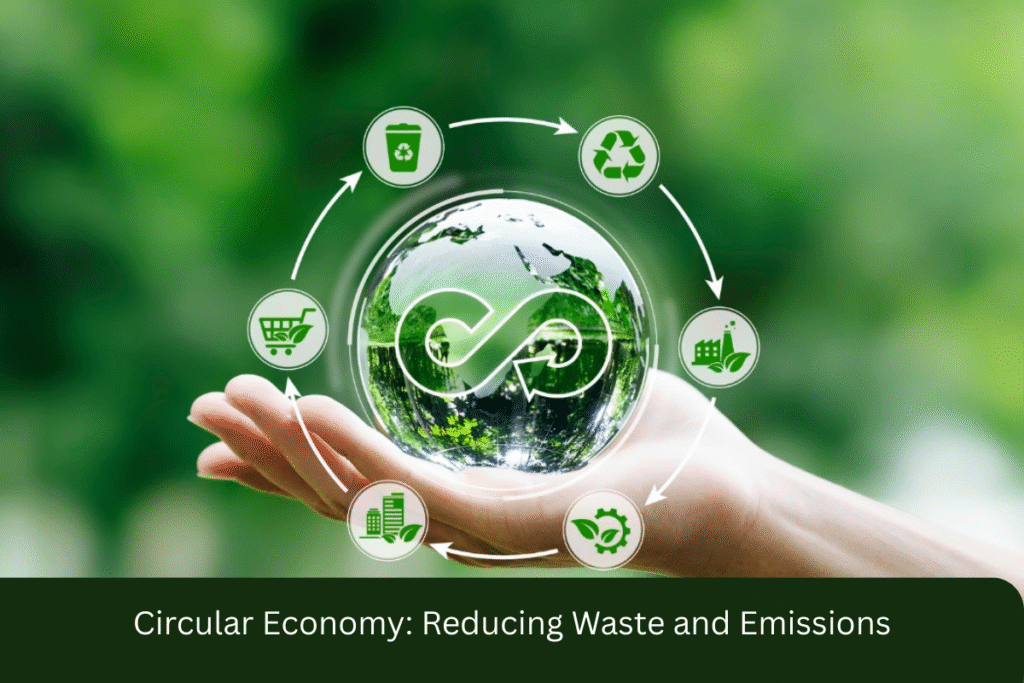
As the world faces mounting environmental challenges, including climate change and resource depletion, the concept of a circular economy has gained significant traction. Unlike the traditional linear economy, which follows a “take, make, dispose” model, the circular economy emphasizes reducing waste, reusing resources, and closing the loop of product life cycles. By minimizing waste and emissions, circular economy principles offer a pathway to more sustainable production and consumption patterns. In this article, we’ll explore what a circular economy is, how it works, and how it contributes to reducing waste and emissions.
1. What is a Circular Economy?
A circular economy is an economic model that contrasts with the traditional linear economy, which follows the steps of extraction, production, consumption, and disposal. In a circular economy, the focus is on sustainability, resource efficiency, and waste reduction. Rather than discarding products after use, a circular economy seeks to keep products, materials, and resources in use for as long as possible through processes like reuse, repair, refurbishment, remanufacturing, and recycling.
The goal of a circular economy is to:
- Reduce waste by ensuring that products and materials are reused and repurposed.
- Maximize the lifespan of products, thereby reducing the need for new raw materials.
- Minimize environmental impact, particularly by reducing carbon emissions and the extraction of finite resources.
This model can be applied across industries, from manufacturing to agriculture, and helps to create more sustainable and regenerative systems that benefit both the environment and the economy.
2. Key Principles of a Circular Economy
A circular economy operates on several core principles that guide the redesign of products and business models for sustainability. These include:
a. Design for Longevity
Products are designed to last longer and be easily repaired, upgraded, or refurbished. Instead of being discarded after a single use or a short lifespan, they are maintained and reused, thus reducing the demand for new raw materials and minimizing waste.
b. Maintain and Extend Product Life
In a circular economy, there is an emphasis on maintaining products for as long as possible through regular maintenance, repair, and upgrades. For example, electronics and appliances are designed to be modular, allowing for easy replacement of parts and extending their useful life.
c. Reuse and Recycle Materials
Instead of discarding used materials, circular economies promote the reuse and recycling of components. Recycling reduces the need for virgin resources and minimizes the energy and emissions associated with extracting and processing raw materials.
d. Regenerative Design
This principle involves creating products and systems that are not only sustainable but also restorative. For example, a regenerative approach in agriculture encourages soil health and biodiversity by using methods like crop rotation, organic farming, and reduced pesticide use.
3. How the Circular Economy Helps Reduce Waste and Emissions
The transition to a circular economy has the potential to significantly reduce both waste and emissions. Here’s how:
a. Minimizing Resource Extraction and Waste Generation
In a circular economy, the extraction of raw materials is minimized by reusing existing materials and components. This reduction in extraction helps lower energy consumption and reduces emissions associated with mining, logging, and other resource-extraction activities.
Additionally, by reusing and recycling materials, the amount of waste generated is drastically reduced. Instead of sending products to landfills or incinerators, they are repurposed, refurbished, or recycled, thereby contributing to the reduction of waste and landfill emissions.
b. Reducing Carbon Emissions
The production of new goods is energy-intensive and contributes to greenhouse gas emissions. By extending the life of products and utilizing recycled materials, the need for new production processes is diminished, resulting in lower emissions. For example:
- Recycled materials typically require less energy to process than virgin materials, reducing overall energy consumption.
- Manufacturing with recycled materials helps companies cut down on emissions, particularly when using materials like metals, paper, and plastics that are commonly recycled.
c. Sustainable Product Lifecycle Management
Circular economy practices encourage companies to manage the entire lifecycle of their products. This includes designing products that are easy to disassemble, repair, and recycle, and implementing take-back schemes where products are returned after use for reuse or recycling. These practices ensure that materials stay in circulation for longer, reducing the need for constant production of new goods and the emissions associated with that production.
d. Reducing Waste in Industries
Industries that adopt circular economy principles can reduce industrial waste by improving supply chain efficiency and repurposing by-products. For example:
- Industrial symbiosis: This is when waste or by-products from one industry are used as raw materials in another industry. By adopting this approach, companies can significantly reduce waste and lower their overall emissions.
4. Examples of Circular Economy in Action
Many businesses and industries are already applying circular economy principles to reduce waste and emissions. Here are a few examples:
a. The Fashion Industry
The fashion industry is notorious for its wastefulness and environmental impact. However, brands are starting to embrace circular economy models by designing clothes that can be recycled or reused. Companies like Patagonia and H&M have launched initiatives that allow customers to return old garments for recycling or reuse, reducing the amount of clothing that ends up in landfills.
b. The Electronics Industry
Electronics manufacturers are increasingly adopting circular economy practices. Companies like Apple and Dell are designing products that can be disassembled and reused or recycled. Apple’s Trade In program, for instance, allows customers to return old devices in exchange for credit or recycling, reducing e-waste and the demand for new raw materials.
c. The Food Industry
The food industry also benefits from circular economy practices. Food waste recycling initiatives turn organic waste into compost or biogas, reducing the environmental footprint of food production. Additionally, companies like Loop are promoting reusable packaging for consumer goods, helping to eliminate single-use plastic waste.
5. FAQs
1. What is a circular economy?
2. How does a circular economy reduce waste?
3. How does the circular economy help reduce emissions?
4. What industries benefit from a circular economy?
5. What are the challenges of implementing a circular economy?
6. Conclusion
The circular economy presents a transformative opportunity to reduce waste, lower emissions, and build a more sustainable future. By adopting circular economy practices, businesses, industries, and consumers can play a pivotal role in creating a low-carbon, resource-efficient economy. As more organizations embrace these principles, the potential for reducing environmental impacts grows, contributing to global climate goals and ensuring a sustainable planet for future generations.
